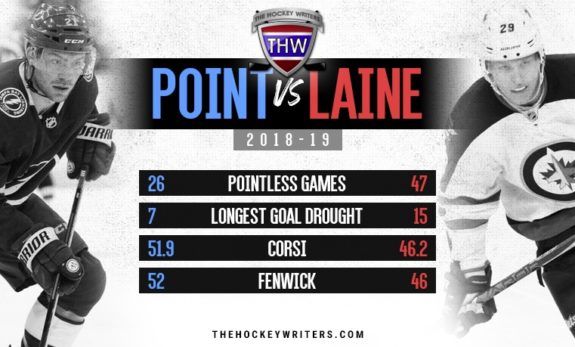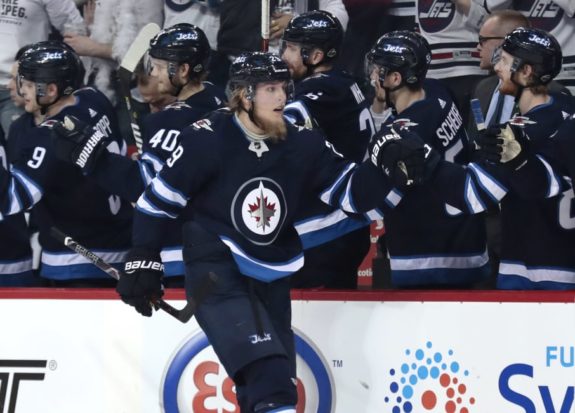The Winnipeg Jets should use Brayden Point’s new contract as a blueprint for the Patrik Laine negotiations. The Tampa Bay Lightning centre recently signed a three-year deal with an average annual value (AAV) of $6.25 million.
A bridge deal has been long-suggested as the more appropriate option for Laine over a long-term contract, as questions still abound about his ultimate ceiling as an everyday contributor. A deal similar to Point’s would suit the Jets’ sometimes incredible but often invisible winger.
Players Are Different, but Offensive Output Is Similar
The two may play a different style of game — Point is a play-maker with a great net-front presence while Laine is a pure shooter — their numbers from their entry-level contract days are similar.
Over his three-year career, Point has 91 goals and 107 assists for 198 points, while Laine, over three seasons, has recorded 110 goals and 74 assists for 184 points.

The 23-year-old Point posted 41 goals and 51 assists last season for the squad that earned 62 wins and captured the Presidents’ Trophy — his best offensive output in a single season by 26 points. The 21-year-old Laine, meanwhile, lit the lamp 30 times and picked up 20 assists in 2018-19 — his worst output by 14.
Point More Prolific Than Laine Thus Far
Although the numbers are similar, Point has been more consistent. A strong two-way player with a propensity for coming up clutch, Point was a huge contributor to the Lightnings’ runaway success last season.
Related: Lightning’s Point Deserves to be All Star
Unlike Laine, who can run hot as Hades (he had an 18-goal November) but can also go ice-cold for weeks or months on end (he only scored six goals after New Year’s), Point was the essence of evenness.

Laine was pointless in 47 of his 82 games — and doesn’t play a strong enough defensive game to help the Jets when he’s not scoring — Point was held off the scoresheet just 26 times.
Laine’s longest goal drought was 15 games and spanned more than a month, while Point never went more than seven games without tickling twine.
Point’s possession numbers were also vastly superior. His Corsi For percentage was 51.9 compared to Laine’s 46.2, and his Fenwick For percentage was 52 compared to Laine’s 46.
Laine Doesn’t Deserve More Than Point
Laine now-infamously told a Finnish newspaper earlier this month that he hasn’t had the chance to play with the Jets’ “best players”, unlike Point, who’s had the pleasure of playing alongside both reigning Art Ross Trophy winner Nikita Kucherov and perennial All-Star Steven Stamkos. That’s true, but Point earned the right and Laine has not.
“Laine will have a hard time convincing anyone he should be paid a penny more than Point,” the Winnipeg Free Press’ Mike McIntyre wrote recently. “If he truly believes he should, well, don’t expect him back any time soon. Laine can complain all he wants about how he’s used at five-on-five and which line he plays on, but the numbers don’t lie,”
(from ‘Young NHL stars’ done deals give Jets, Laine, Connor, roadmap to resolution,’ Winnipeg Free Press, 09/23/19).

If there’s any area in which the Jets should play ball with Laine’s camp, it’s on the structure. Point’s AAV is highest ($9 million) in the final year of his contract, which benefits him because other teams’ qualifying offers will have to match his salary. Laine would likely desire something similar.
But the Jets shouldn’t play ball on dollars and cents. The Lightning have provided a clear blueprint for a bridge deal, and the Jets shouldn’t pony up more than the NHL’s top organization gave a more complete player.
The 2019-20 season is nearly upon us, and Point’s contract should move the discussion between the the Jets and Laine forward quickly — perhaps not quickly enough to have him in uniform for Oct. 3’s season opener in the Big Apple, as predicted nearly two months ago — but quick nonetheless. That is, unless Laine’s camp has an inflated view of his skills.